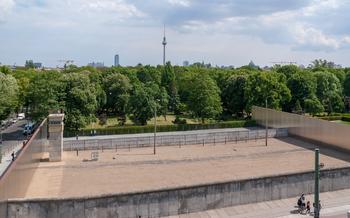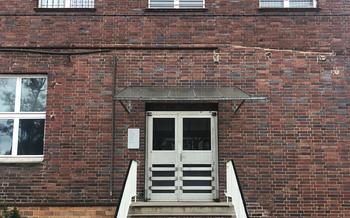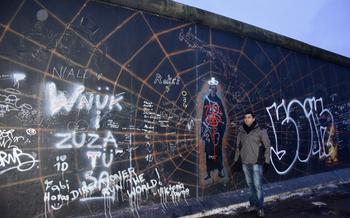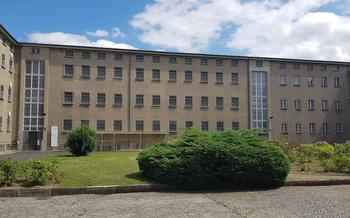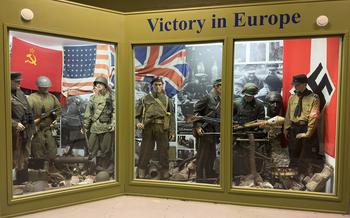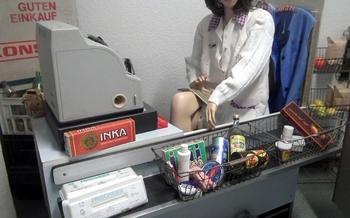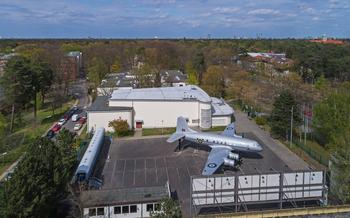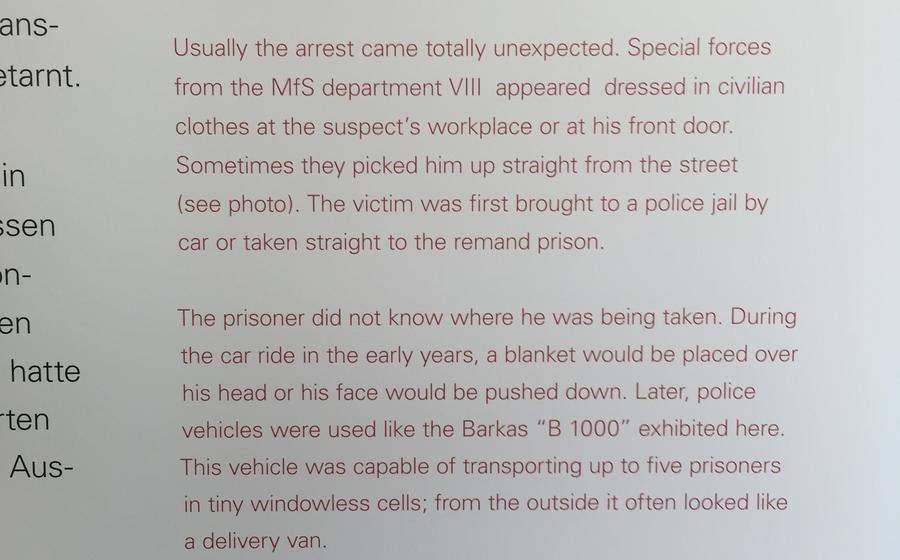
The Stasi Museum
- A Journey Through History
- Unveiling the Stasi Headquarters
- Interactive Exhibitions
- Personal Stories and Testimonies
- Historical Context
- Guided Tours
- Temporary Exhibitions
- Educational Workshops
- Virtual Reality Experience
- Research Opportunities
- Museum Shop: Souvenirs and Support
- Accessibility
- Insider Tip: Hidden Gems
A Journey Through History
The Stasi Museum, located in the heart of Berlin, offers a chilling journey through the history of the East German secret police, the Stasi. This museum, housed in the former headquarters of the Ministry of State Security, provides a glimpse into the oppressive surveillance and control measures that defined the Stasi regime. Through a vast collection of artifacts, documents, and interactive exhibits, visitors gain a profound understanding of the impact of the Stasi on ordinary citizens' lives during the Cold War era. The Stasi Museum serves as a powerful reminder of the dangers of unchecked power and the importance of protecting individual freedoms and human rights.
Unveiling the Stasi Headquarters
As you step through the gates of the former Stasi headquarters, you'll be transported back in time to an era defined by secrecy and surveillance. Once a highly guarded and impenetrable complex, this vast network of offices, interrogation rooms, and detention cells now stands as a testament to the oppressive reach of the Stasi regime. Its imposing architecture, barbed wire fences, and watchtowers serve as chilling reminders of the fear and paranoia that permeated East German society.
Explore the labyrinthine corridors and discover the intricate structure of the Stasi organization. Learn about the various departments responsible for surveillance, counterintelligence, and internal security. Each room tells a story of meticulous planning, covert operations, and the relentless pursuit of control. From the Stasi's advanced technology to its psychological manipulation tactics, you'll gain insights into the insidious methods employed to maintain a grip on power.
Reflect on the chilling legacy of the Stasi's pervasive presence in East German society. Imagine the lives of those who worked within these walls, driven by ideology and obedience. Consider the countless individuals who were subjected to surveillance, interrogation, and imprisonment, their freedoms and privacy stripped away. The Stasi headquarters stands not only as a monument to a dark chapter in history but also as a poignant reminder of the fragility of freedom and the importance of vigilance against oppressive regimes.
Interactive Exhibitions
Engage your senses and immerse yourself in the interactive exhibits at the Stasi Museum, which bring the oppressive surveillance techniques of the regime to life. Experience the unsettling feeling of being under constant watch through interactive surveillance demonstrations that recreate the Stasi's methods of monitoring citizens' activities. Discover how the Stasi collected and analyzed vast amounts of information, including personal correspondence, phone conversations, and even intimate details of people's lives. These exhibits offer a visceral understanding of the pervasive control and fear that permeated East German society during the Cold War era.
As you navigate the interactive displays, you'll gain insights into the lives of those who lived under the watchful eye of the Stasi. Hear their stories, learn about their struggles, and understand the impact of surveillance on their daily lives. These personal narratives humanize the experiences of those who faced the Stasi's oppressive regime, allowing you to connect with their stories on a deeper level.
Personal Stories and Testimonies
The Stasi Museum provides a platform for former Stasi victims and their families to share their personal accounts and testimonies. These firsthand narratives offer a poignant glimpse into the human toll of the Stasi's oppressive regime. Visitors can listen to harrowing stories of surveillance, persecution, and imprisonment, gaining a deeper understanding of the impact of the Stasi's actions on individuals and their communities.
Through these personal accounts, the museum sheds light on the courage and resilience of those who resisted the Stasi's tyranny. Visitors can learn about the extraordinary measures people took to protect their privacy, maintain their dignity, and fight for their freedom. These stories serve as a powerful reminder of the indomitable spirit of the human spirit, even in the face of adversity.
By listening to these testimonies, visitors gain a deeper appreciation for the sacrifices made by those who lived under the Stasi's watchful eye. Their experiences provide a valuable reminder of the importance of freedom, privacy, and the rule of law. The museum's commitment to preserving and sharing these personal stories ensures that the legacy of the Stasi's victims is never forgotten.
Historical Context
The Stasi did not operate in a vacuum; it was a product of the political and historical context of East Germany. The museum delves into the development of the East German state and its close relationship with the Soviet Union, exploring the ideological underpinnings that shaped the Stasi's activities.
Visitors gain an understanding of the broader implications of the Stasi's actions within the context of Cold War politics. The museum presents the Stasi not just as an isolated phenomenon but as a manifestation of the tensions and divisions that characterized the Cold War era, highlighting the broader implications of its activities for international relations and the global balance of power.
By contextualizing the Stasi within its historical framework, the museum enables visitors to grasp the complex interplay of political, social, and ideological factors that contributed to the rise and operation of this formidable secret police apparatus.
Guided Tours
Elevate your visit to the Stasi Museum by embarking on a guided tour led by knowledgeable experts. These experienced guides will provide insightful commentary and historical context, bringing the museum's exhibits to life. Learn about the specific roles and responsibilities of different Stasi departments, from surveillance to interrogation and beyond. Gain insights into the lives and motivations of Stasi agents and their victims, understanding their perspectives and the human toll of the Stasi's oppressive regime.
Engage in thought-provoking discussions with your guide, asking questions and exploring different viewpoints. Guided tours offer a deeper level of engagement, allowing you to delve into the complexities of the Stasi's history and its impact on East German society. Whether you're a history buff, a student, or simply curious about this dark chapter in Germany's past, a guided tour will enhance your experience and provide a richer understanding of the Stasi's legacy.
Temporary Exhibitions
The Stasi Museum is dedicated to keeping the memory of the Stasi regime alive and relevant to contemporary society. One way it achieves this is through its compelling temporary exhibitions. These exhibitions explore various aspects of Stasi history and related topics, offering visitors new perspectives and insights.
Temporary exhibitions at the Stasi Museum often focus on specific themes or individuals related to the Stasi's activities. They showcase the latest research and scholarship on the Stasi, ensuring that the museum remains at the forefront of historical understanding. Visitors can learn about the Stasi's methods of surveillance, its impact on ordinary citizens' lives, and its role in shaping East German society.
By exploring these temporary exhibitions, visitors gain a comprehensive understanding of the Stasi's legacy and its implications for contemporary society. The museum's commitment to ongoing research and public engagement ensures that the Stasi's history is continuously examined and interpreted, fostering a deeper understanding of this dark chapter in German history.
Educational Workshops
The Stasi Museum offers a range of educational workshops and seminars that delve deeper into the Stasi's surveillance methods, interrogation techniques, and psychological manipulation. These workshops provide a unique opportunity to engage with experts and fellow participants in discussions about the ethical implications of surveillance and the importance of privacy. Through these interactive sessions, participants gain a deeper understanding of the Stasi's impact on East German society and its relevance to contemporary issues.
The workshops cover a wide range of topics, including the Stasi's surveillance techniques, the role of informants and collaborators, the methods of psychological manipulation employed by the Stasi, and the impact of surveillance on individuals and society. Participants engage in group discussions, role-playing exercises, and interactive simulations to gain a deeper understanding of these complex issues.
The Stasi Museum's educational workshops are an excellent opportunity for students, researchers, and anyone interested in learning more about the Stasi and its legacy to engage with the topic in a meaningful and interactive way. By participating in these workshops, participants contribute to the ongoing dialogue about the Stasi's history and its implications for contemporary society.
Virtual Reality Experience
Immerse yourself in a virtual reality (VR) experience that transports you back in time to the oppressive atmosphere of the Stasi's former headquarters. Through the eyes of a Stasi agent or a victim, you'll experience the chilling reality of life under constant surveillance. The VR simulation recreates the Stasi's interrogation rooms, prison cells, and other haunting environments, allowing you to gain a visceral understanding of the fear and paranoia that permeated East German society. This immersive experience challenges you to confront the past and encourages empathy and understanding for those who suffered under the Stasi's brutal regime.
Research Opportunities
The Stasi Museum is not just a place to learn about the past; it is also a center for ongoing research and scholarship. The museum's extensive research facilities and resources provide scholars and researchers with a wealth of opportunities to explore the history of the Stasi and its impact on East German society.
The museum's collection of Stasi files and documents is a treasure trove of information for researchers. These files contain everything from surveillance reports to interrogation transcripts, providing a unique insight into the inner workings of the Stasi. Researchers can also access the museum's library, which houses a collection of books, articles, and other materials related to the Stasi and the GDR.
The Stasi Museum also offers a variety of research programs and fellowships. These programs provide scholars with the opportunity to conduct research at the museum, collaborate with other researchers, and present their findings at conferences and workshops.
The Stasi Museum is committed to supporting research on the history of the Stasi and its legacy. By providing scholars and researchers with access to its collection and resources, the museum helps to ensure that the memory of the Stasi's crimes will not be forgotten.
Museum Shop: Souvenirs and Support
At the Stasi Museum, you can delve into a treasure trove of books, films, and souvenirs related to the history of the Stasi. These carefully curated items offer a tangible connection to the museum's mission of preserving and educating. Books provide in-depth accounts of the Stasi's activities, shedding light on its inner workings and impact on society. Films offer a visual narrative, bringing the stories of victims and perpetrators to life. Souvenirs, ranging from postcards to replicas of Stasi uniforms, serve as reminders of the museum's powerful message.
By purchasing items from the museum shop, you not only enrich your understanding of the Stasi but also contribute directly to the museum's operations. Your support enables the museum to continue its vital work of preserving the Stasi's legacy, conducting research, and organizing educational programs. Furthermore, your purchase contributes to the museum's ongoing efforts to digitize and make accessible its vast collection of files and documents, ensuring that future generations can learn from the past.
So, as you browse the museum shop, consider selecting a book or film that resonates with you. Choose a souvenir that will serve as a reminder of your visit and the stories you encountered. By doing so, you become part of the museum's mission to educate and inform, ensuring that the Stasi's legacy is never forgotten.
Accessibility
The Stasi Museum is committed to providing an accessible and inclusive experience for all visitors. The museum's website offers comprehensive information on wheelchair accessibility, audio guides, and other assistive devices. Visitors with disabilities are encouraged to contact the museum in advance to arrange for any special accommodations they may require.
The museum's staff is trained to assist visitors with disabilities and ensure that everyone has the opportunity to learn about and engage with the history of the Stasi. The museum also offers a variety of educational programs and resources that are designed to be accessible and inclusive for all visitors.
By providing accessible features and services, the Stasi Museum strives to create a welcoming and inclusive environment for all visitors, regardless of their abilities or disabilities.
Insider Tip: Hidden Gems
As you explore the Stasi Museum, keep an eye out for hidden gems that offer unique insights into the Stasi's activities and the lives of those affected by it. In a secluded corner of the museum, you might find a display of personal belongings confiscated from Stasi victims, revealing the human toll of the regime's surveillance and persecution. Seek out interactive exhibits that allow you to experience the feeling of being under constant watch, providing a visceral understanding of the paranoia that permeated East German society.
Engage in conversations with museum staff and fellow visitors to uncover hidden stories and perspectives. They may share personal anecdotes or point you towards lesser-known exhibits that shed light on specific aspects of the Stasi's operations. Don't forget to explore the surrounding area, where you can find other landmarks related to the Stasi and East German history, such as the former Stasi headquarters building or the Berlin Wall Memorial. These hidden gems and personal encounters will enrich your visit and provide a deeper understanding of the Stasi's legacy and its impact on the lives of ordinary people.
